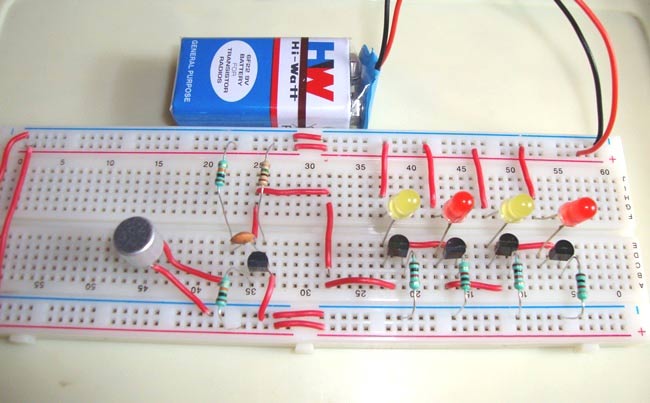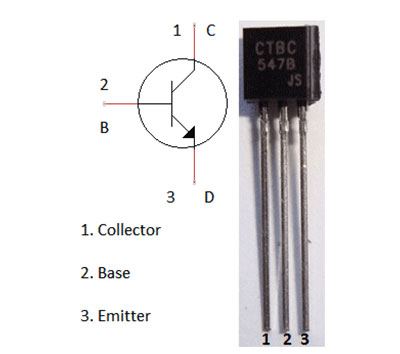
You must have seen the Disco Lights or DJ lights, which Turn ON and OFF according to the beats of the music. These lights glow according to the length and pitch (volume) of music beats, basically these are designed to pick the high intensity sound like Bass sound. So these lights follow the high pitch beats in music like drum beats, and Turn ON and OFF according to music pattern. However the sensitivity of the circuit can be increased to pick the low notes too.
Previously we have built Dancing LEDs, which just follow a set pattern and we can only control the speed. Now we are taking this to next level, i.e. Music Operated Dancing LEDs, in which LEDs will flash according to music, just like Disco light, as discussed above. This Musical LEDs circuit is based on transistor BC547. This circuit is very simple and easy to build, it just requires few basic components and it looks very cool.
Components:
- Condenser Mic
- 5- NPN Transistor BC547
- Resistors- 10k (2), 1k (4), 1M (1)
- Ceramic Capacitor 100nF
- 4 – LEDs
- 9v Battery
- Breadboard and connecting wires
Working Explanation:
In this Simple LED Music Light Circuit, condenser mic picks up the sound signals and converts them into voltage levels. These voltage signals are further fed into R-C filter or HIGH PASS filter (R2 and C1), to eliminate the noise from the sound. Further a NPN transistor (Q1- BC547) is used to amplify the signals, from the High Pass filter. Then finally these music signals are given to the array of four transistors. Transistor in this array works as amplifier, and glows the four LEDs according to the sound pattern. This generates a very interesting sequence of dancing LEDs which follows the beats as per their intensity or pitch. We can also add more LEDs with transistor to make it cooler.
We can adjust the sensitivity of MIC by changing the value of R2 and C1, by using the formula for R-C filter:
F = 1/ (2πRC)
F is the cut off frequency, means filter only allow frequency above than F. It can be easily deduced that more the value of RC, less the cut off frequency and higher the sensitivity of MIC. And higher the sensitive of circuit means MIC can pick low volume sounds, hence LEDs can glow on low pitch music also. So by adjusting its sensitivity we can make it less sensitive to reacts only on high note beats or we can also make it more sensitive to react on every little beat in the music. Here we have set its sensitivity at moderate level.
Condenser Mic should be connected properly in the circuit, according to its polarity. To determine the polarity of MIC one should look at mic terminals, the terminal which have three soldering lines, is the negative terminal.
Transistor BC547 is a NPN transistor, which is used as a Amplifier here. NPN transistor acts as a open switch when there is no voltage applied on its Base (B) and it acts as closed switch when these is some voltage at its base. Generally 0.7 volt is enough to get it fully conducted.

Comments
Are you talking about Simple
Are you talking about Simple Flashing LED using 555 Timer IC
Hey Maddy, i really love your
Hey Maddy, i really love your project, its one amazing piece..... I've been trying to make little changes to mine but i've got no idea how to replace the mic with a speaker and audio jack :(... I hope you can show it on a circuit diagram... Thanks for understanding. :)
Check this one: Small
Check this one: Small Loudspeaker for Computer or Cell Phone
please someone tell me
please someone tell me application of this circuit?
Can I know what can be the
Can I know what can be the other components which can be used apart from Mic....
Not working
Hello,
Do you mind looking at my circuit and see what the problem is? I believe I have everything connected properly.
Thanks!
not working
I have made all the connections as such in the circuit but its not working even after varying the value of r2 please help its urgent...
can I use any other capacitor
can I use any other capacitor at the place of ceremic capacitor 100nf
how to calculate the value of
how to calculate the value of its components?
sound indicater
I want a sound indicating circuit .
by use 12v led
such an amazing job! this
such an amazing job! this project is on the list of the projects we can do in linear circuit course at my uni. they also put this sites url as a reference
Can i use 5V battery instaed
Can i use 5V battery instaed of 9v
What is different??
This but with AC
How this may work with a regular light bulb and AC? Thanks!
complain about not the working the circuit
plz explain each component connection clearly, as we have tried three times it is not working.....
what is yhe working frequency
what is yhe working frequency of circuit?
I want to use a 12V input for
I want to use a 12V input for the circuit and 4 leds in series in every group. What changes do i have to make? Thank you!
How the whole circuit works....?
I want to know that how these circuits are working? And what is the role of capacitor,will it effect on incresing or decreasing it.Can be add more LEDs and transistor in this cicuit without changing the configuration of the cicuit.
Can I use BC548 instead of
Can I use BC548 instead of 547?Will my circuit work?
if i use 1w led which
if i use 1w led which transistor is to be used instead bc547 and value of r4 please?
Replacement of mic
What changes should I do to replace mic with audio jack input??
Can i use a monophone pin
Can i use a monophone pin instead of the mic
can anyone please tell what
can anyone please tell what is the function of capacitor in circuit?
Thanks a lot for this post,
Thanks a lot for this post, helped me a lot.
For those who can't get it to work ignore everything to the right of LED1 and replace your mic with a simple audiojack coming from your pc/radio/whatever. This way you can easier tune the volume (too high volume leads to leds being always on).
If you don't want to cut a cable the head of the jack should be ground.
I just have to thank you
I just have to thank you again.
Thanks to this post i just build a 6 "band/led" spectrogram.
Similar to your circuit but with 1 lowpass, 4 bandpass and 1 highpass filter in parallel each driving one LED amplified via an NPN transistor.
This is the first electronics "project" i did which is almost useable.
Thanks again,
an enthusiastic beginner
can I replace 3.5mm jack in
can I replace 3.5mm jack in the place of microphone
Dec 04, 2019
Can I use a plc (Programmable logic controller) in this circuit?
Would appreciate it if someone answered.
Q1 needs to be a BC557 PNP
Q1 needs to be a BC557 PNP transistor.
Instead of using a condenser…
Instead of using a condenser MIC, is it possible to directly use the headphone wires?
It means the headphone jack is plugged into the jack port in the smartphone, while the mic wire and ground wire are inserted in the board.
Then the music is opened on the smartphone







Hey Maddy.. Ur project is awsm..
I hve one question. This cct is on DC if I wan to connect ac current then?? Of 230v..